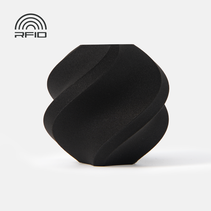Bambu Lab ASA Aero
| SKU: | B02-W0-1.75-1000-SPL |
| EAN: | 6975337036715 |
| Location Code: | GAS5P3R4 |
- Premium service and support
- Eenvoudige mogelijkheid voor leasen.
- Gunstige verzendvoorwaarden en retourbeleid
- Fysieke showrooms op diverse locaties in Nederland
- 2-6 Days
- Customer service from 10:00 to 17:00
Product Features
- Tough with Good Impact Resistance
- Ultra-lightweight & Low Density
- Water & UV Resistance
- Comes with High Temperature Reusable Spool
- Diameter: 1.75 mm +/- 0.03 mm
Cautions for Use
- Dry out before Use
- AMS Compatible
- Enclosure Printers Required
Bambu ASA Aero
Bambu ASA Aero is a self-foaming material renowned for its exceptional durability and toughness. Its heat-sensitive foaming allows for controlled model density, resulting in feather-light print models. Additionally, it boasts extraordinary resistance to temperature, water, and UV rays. With these unique properties, it is ideal for printing long-lasting outdoor models and weight-sensitive projects, such as RC planes.
Impact Resistance & Built to Last
Compared with other foaming filament, ASA Aero is tougher with higher layer strength, making it more resistant to impact, collision, and falling, perfect for high-stress demanding applications.
Ultra-lightweight, Controllable Density
Only 50%-75% the density of regular ASA prints, ASA Aero is as light as feather, designed for weight-sensitive objects, such as RC planes and unmanned aerial vehicles (UAVs). With controllable foaming characteristic, ASA Aero achieves lower density of prints by increasing printing temperature or lowering flow rate.
Printing Tips
• Foaming ASA materials (ASA Aero) have high requirements for material drying and parameter settings. Please carefully read ASA Aero Printing Guide before starting the printing process.
• Drying conditions: 80℃ for 8 hrs. ASA Aero is highly sensitive to humidity. To achieve optimal printing performance, it is recommeded further drying before use and after storage. For more details please refer to: Filament Drying Recommendations on WIKI.
• To minimize warping, avoid printing large-sized high infill density models. Use enclosed printers and ensure the build plate is properly applied with glue for better print adhesion before printing. Set lower printing speed and higher heatbed temperature. For more details please refer to: Common print quality problems and solutions on WIKI.
• Pungent and unpleasant odors may be released during printing. Make sure your printer is placed in a well-ventilated area and use enclosed printers.





